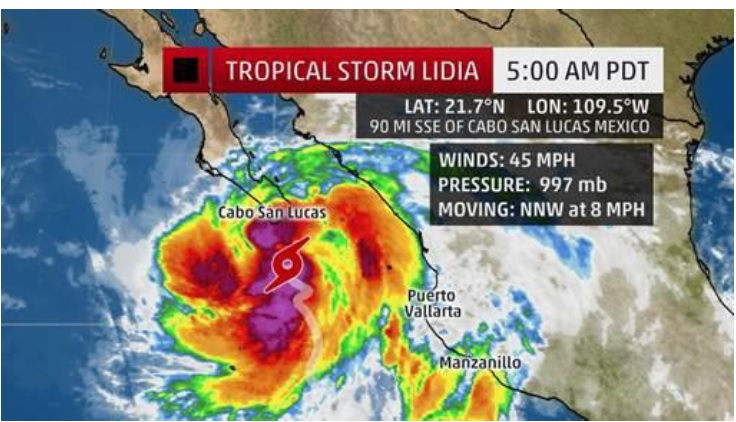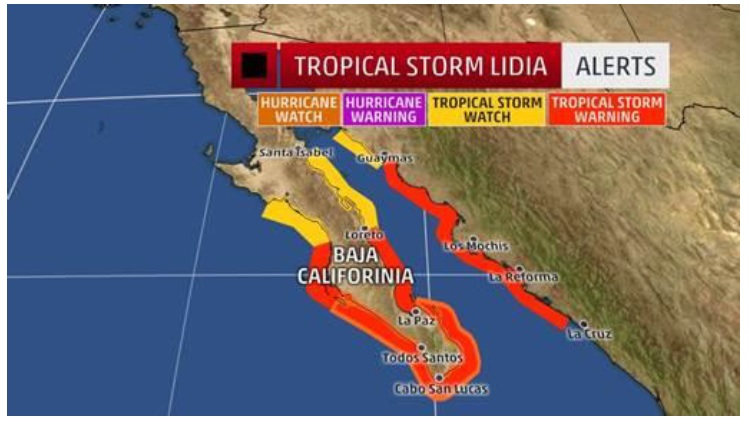September 20, 2017
Hurricane Maria, now reduced to a Category 4 hurricane after battering the U.S. Virgin Islands as a Category 5 storm, has “life–threatening” winds of 155 mph and flooding in Puerto Rico, according to the National Hurricane Center. Reports say Puerto Rico was hit with a force “not seen in modern history.” Maria has killed at least 7 people on the Caribbean island of Dominica.
Major airlines have travel waivers in place, including: American Airlines, Delta Air Lines and United Airlines.
According to the Telegraph:
Hurricane Maria is pummelling Puerto Rico, bringing “catastrophic” 155mph winds and dangerous storm surges, after battering the Virgin Islands.
The “monster” storm is one of the strongest to ever hit the US territory, with warnings that heavy rain could cause landslides and storm surges of up to 9ft that risk swamping low-lying areas.
Maria began lashing the US Virgin Island of St Croix early on Wednesday, as it continued to cut a deadly north-westerly path through the Caribbean.
According to CNN:
Hurricane Maria pummeled Puerto Rico on Wednesday morning, ripping trees out of the ground and hammering two-thirds of the island with hurricane-force winds.
“This is total devastation,” said Carlos Mercader, a spokesman for Puerto Rico’s governor. “Puerto Rico, in terms of the infrastructure, will not be the same. … This is something of historic proportions.”
Seven deaths on the Caribbean island nation of Dominica were blamed on the hurricane, said Gaston Browne, the Prime Minister of Antigua and Barbuda. Browne said he had been communicating with the Prime Minister of Dominica, Roosevelt Skerrit, whose own house was shredded by the storm.
Maria made landfall in Puerto Rico on Wednesday near the city of Yabucoa with winds of 155 mph, the National Hurricane Center said. By 10 a.m., those winds had weakened to 145 mph, but Maria was still a Category 4 hurricane capable of ripping roofs off houses.
The storm was so fierce, it broke two National Weather Service radars on the island.
According to the National Hurricane Center:
WATCHES AND WARNINGS
——————–
CHANGES WITH THIS ADVISORY:
The government of France has discontinued the Tropical Storm Warning
for St. Martin and St. Barthelemy.
The government of St. Maarten has discontinued the Tropical Storm
Warning and Hurricane Watch for St. Maarten.
The government of the Netherlands has discontinued the Tropical
Storm Warning for Saba.
SUMMARY OF WATCHES AND WARNINGS IN EFFECT:
A Hurricane Warning is in effect for…
* U.S. Virgin Islands
* British Virgin Islands
* Puerto Rico, Culebra, and Vieques
* Dominican Republic from Cabo Engano to Puerto Plata
* Turks and Caicos Islands and the Southeastern Bahamas
The NY Times reports:
Hurricane Maria made landfall on Puerto Rico as a powerful Category 4 storm early Wednesday, cutting electricity and phone lines, sending thousands of people into shelters and raising the prospect of deadly floods. The storm was bringing new misery to a region that has seen two other powerful hurricanes, Irma and Jose, in recent weeks.
As of 9 a.m., the eye of the storm was about 15 miles west-southwest of San Juan, having hit Yabucoa in the southeast shortly after 6 a.m. It had crossed the United States Virgin Islands as a Category 5 storm, then weakened slightly but remained “extremely dangerous,” with heavy rain and winds of up to 155 miles an hour.
As the hurricane moved in, residents across the island were awakened by the clamor of strengthening wind gusts.
“For Irma, we were very prepared,” Gov. Ricardo Rosselló said on CNN on Wednesday morning. “Unfortunately, of course, now we’re feeling a second storm in two weeks, and this one much more devastating than the first one. Who knows what the damage will be?”
Flooding and mudslides are major concerns, he warned, and the rain that follows the brunt of the storm could be just as dangerous as the winds.
Please contact the PR Team if you have any questions or concerns: TravelLeadersGroupPR@TravelLeaders.com.


